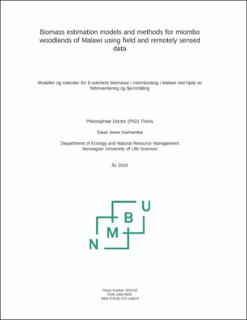| dc.contributor.advisor | Eid, Tron | |
| dc.contributor.advisor | Gobakken, Terje | |
| dc.contributor.advisor | Ørka, Hans Ole | |
| dc.contributor.advisor | Mwase, Weston | |
| dc.contributor.author | Kachamba, Daud Jones | |
| dc.coverage.spatial | Malawi | en_US |
| dc.date.accessioned | 2020-11-24T10:25:13Z | |
| dc.date.available | 2020-11-24T10:25:13Z | |
| dc.date.issued | 2016 | |
| dc.identifier.isbn | 978-82-575-1406-8 | |
| dc.identifier.issn | 1894-6402 | |
| dc.identifier.uri | https://hdl.handle.net/11250/2689287 | |
| dc.description.abstract | Dry tropical forests, such as the miombo woodlands, play an important role in the global carbon budget as well as in contributing towards the sustainable development of countries such as Malawi. To ensure sustainability of these forests, availability of models and methods for assisting forest managers in quantifying volume and biomass are indispensable. This thesis therefore sought to develop volume and biomass prediction models as well as to test the potential of applying unmanned aerial vehicles (UAVs) in biomass prediction and estimation in miombo woodlands. In Paper 1 and 2, we developed models for predicting tree sectional (twigs, merchantable stem and branches) volume and biomass, total tree volume as well as tree above-and belowground biomass. The performances and evaluations suggested that the models can be used over a wide range of geographical and ecological conditions in Malawi with an appropriate accuracy in predictions. Application of UAVs for biomass prediction and estimation were tested and the results are presented in Papers 3 and 4. In Paper 3, we tested methods to derive digital terrain models (DTMs) while Paper 4 focused on the assessment of the efficiency of UAV-assisted inventories as well as the influence of sample plot sizes and number of sample plots on the precision of biomass estimates. The results, presented in Paper 3, show that among the tested DTMs, the model developed from unsupervised ground filtering based on a grid search approach performed best. Furthermore, the observed prediction errors for the biomass predictions are similar to results from previous studies using airborne laser scanning (ALS) data, thus showing the potential of applying this technology in miombo woodlands. Finally, Paper 4 demonstrated that UAV-assisted inventories produce more precise estimates compared to those based on purely field-based inventories. The results also indicated that large sample plot sizes and sample sizes favour UAV-assisted inventories and that UAV-assisted inventories are more efficient than purely field-based inventories. The developed models and the results from the tested methods presented in the thesis have taken us some steps forward that are expected to support and improve forest management decision-making in general as well as the implementation of a REDD+ MRV system covering the miombo woodlands of Malawi. | en_US |
| dc.description.sponsorship | World Wildlife Fund ; Capacity Building for Managing Climate Change (Malawi) | en_US |
| dc.language.iso | eng | en_US |
| dc.publisher | Norwegian University of Life Sciences, Ås | en_US |
| dc.relation.ispartofseries | PhD Thesis;2016:92 | |
| dc.rights | Attribution-NonCommercial-NoDerivatives 4.0 Internasjonal | * |
| dc.rights.uri | http://creativecommons.org/licenses/by-nc-nd/4.0/deed.no | * |
| dc.title | Biomass estimation models and methods for miombo woodlands of Malawi using field and remotely sensed data | en_US |
| dc.title.alternative | Modeller og metoder for å estimere biomasse i miomboskog i Malawi ved hjelp av feltinventering og fjernmåling | en_US |
| dc.type | Doctoral thesis | en_US |

